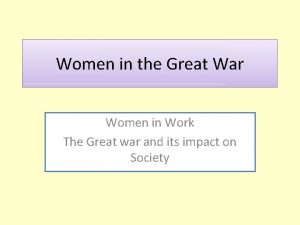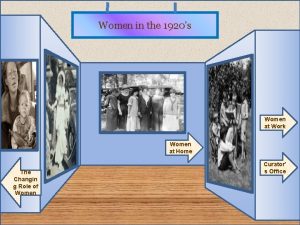Women in the Great War Women in Work













- Slides: 13

Women in the Great War Women in Work The Great war and its impact on Society

Todays Lesson • You will understand more about gender equality in our society • You will be able to compare the equality with todays society with the gender equality of the 1900’s • You will be able to understand about the role of women in society before WW 1

Todays Society Discuss • Discussion and write down your ideas 1. Do you think there is gender equality in todays society? 2. You have any examples where equality exists or does not exist? • Write down and discuss all your ideas

Facts about women today • Women are outnumbered 5 to 1 by men in the cabinet 16% of senior ministerial posts are held by women. • 22% of MPs in the House of Commons are women. • 20% of members of the House of Lords are women • Only 4/23 members of the UK Cabinet are women. • Of the top 1000 companies in the USA, only 25 are run by women. • In the top ten paying jobs for women, females earn less than men; only one career -- speech pathology -- pays the same regardless of gender.

Facts about women today • The full time gender pay gap is 10% – the average part-time pay gap is 34. 5% • It is estimated that for each year a mother is absent from the workplace her future wages will reduce by 5%. • 70% of the working population earning minimum wage are women • 54% of women working part-time have been found to be ‘employed below their potential’, which amounts to 2. 8 million women.

Women in British Society 1900’s Discuss • Discuss and write down your ideas 1. What position do you think most women held in British society in the 1900’s? 2. What rights and responsibilities did most women have?

Marriage and Family • Family was considered to be important in a quickly changing society. Queen Victoria was seen as the perfect role model. • Marriage was thought to enhance the identity and status of all women. • Divorce had to be granted by an Act of Parliament. Easier for men than women. It was considered to be scandalous. ** The Matrimonial Causes Act 1857

Middle and Upper Classes Head of the household Goal: to find a good job Did as her husband asked Goals– to find a decent Husband with a large income and have children Unmarried women were seen as failures to be ridiculed and pitied Was it a male or a female dominated world?

Middle and Upper Classes • Women were educated and brought up to fit her ‘role’ and to be dutiful. • Women were to be gentle, ladylike and appear to be less intelligent than her husband. They had to be able to run an efficient house, have a large family, and be faithful. • On surface marriage was happy and stable but there was a lot of hypocrisy.

Working class • Working class wanted to aspire to middle class ideal but were held back by: 1 - Poverty and poor housing. Led to a life of hard work and childbearing. 2 -Cruelty- men had a brutal attitude enhanced by overcrowding and alcohol. 3 -Lack of education and legal rights meant they couldn’t escape an unsatisfactory marriage.


Women in work • Lower class women in Scotland – – – – domestic servants jobs in factories and workshops, farms fishing ports laundry work All these jobs were poorly paid Children would also contribute to the family’s income by working as soon as they were old enough, usually by 12 years old. • Middle Class Women – housewives and to spend their time looking after their house and children. – Unmarried or widowed middle class women would work in ‘respectable’ occupations such as governesses, teachers and nurses

Task • Complete the task sheets • Women at work before 1914 • Domestic service • If you have finished both tasks • Write two paragraphs explaining the difference between women’s equality in todays society and society before 1914
 Why have there been no great women artist
Why have there been no great women artist What challenges did madison face abroad
What challenges did madison face abroad Vietnam war
Vietnam war Lesson 1 the origins of the cold war
Lesson 1 the origins of the cold war Sclc and sncc venn diagram
Sclc and sncc venn diagram Was josette dugas pro war
Was josette dugas pro war Sein remse
Sein remse Studyjams force and motion
Studyjams force and motion Why was the civil war considered the first modern war
Why was the civil war considered the first modern war Ich war du warst er war
Ich war du warst er war Toward civil war lesson 3 secession and war
Toward civil war lesson 3 secession and war Sides in cold war
Sides in cold war Chapter 30 the war to end war
Chapter 30 the war to end war Chapter 30 the war to end war
Chapter 30 the war to end war

























